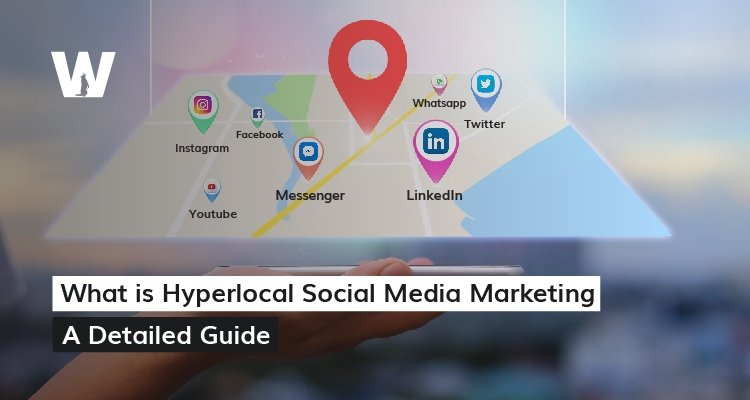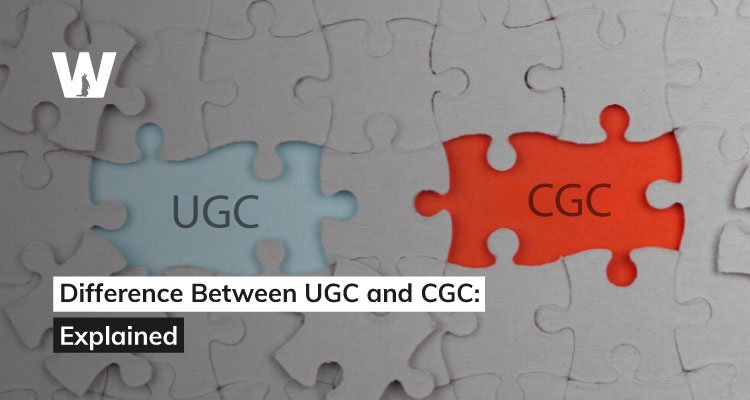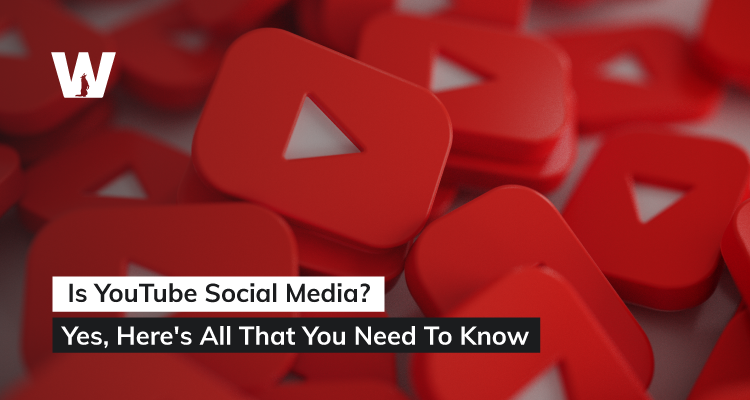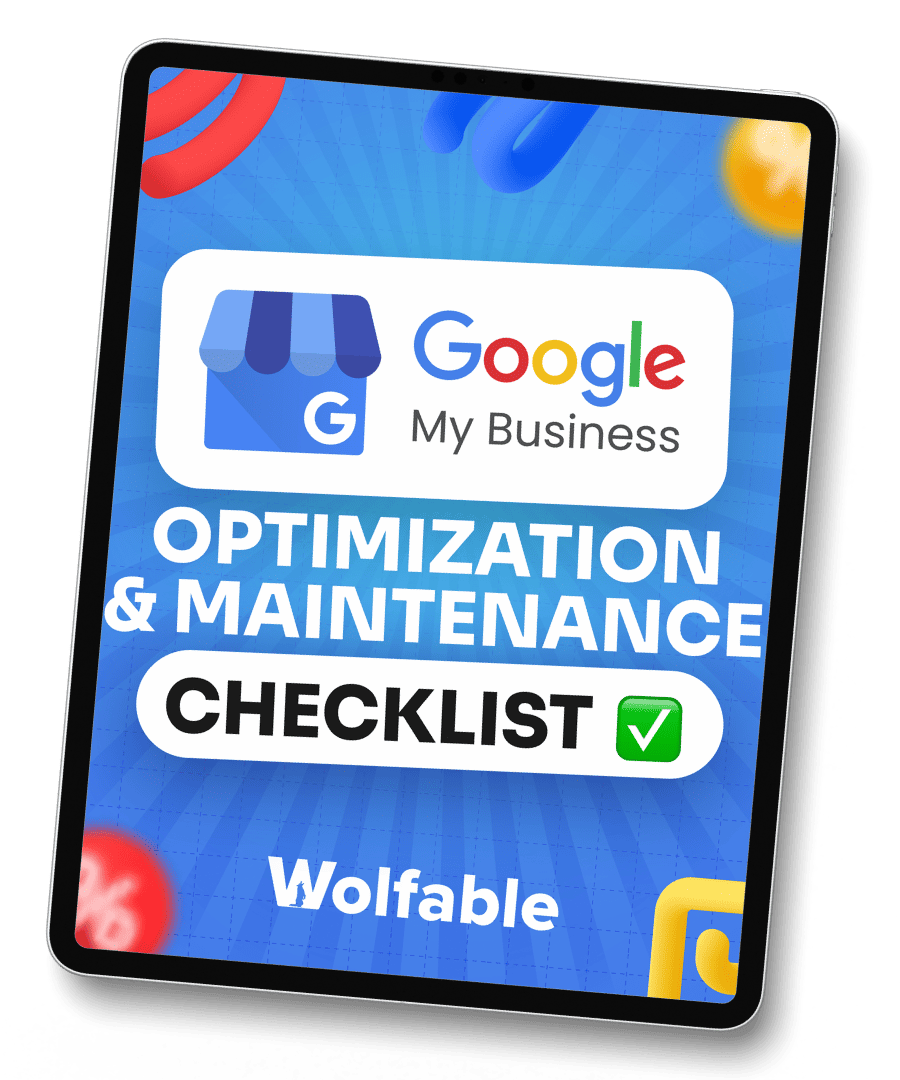Wraps up in 5 Minutes
Hyperlocal social media marketing is a concept that might sound confusing at first, but it's actually pretty straightforward.
In essence, it's all about tailoring your social media marketing efforts to target audiences in specific geographic locations.
Think about it this way — when you're running a local business, you want to reach people who live or work in the areas you serve. Traditional social media marketing might cast too wide a net, but hyperlocal social media marketing allows you to laser-focus your message on the people who matter most to your business.
And the best part? Hyperlocal social media marketing can lead to better targeting, higher engagement, and cost-effectiveness.
In this post, we’ve discussed everything about hyperlocal social media marketing, including benefits, strategies, best practices, and real-world examples.
What is Hyperlocal Social Media Marketing?
Hyperlocal social media marketing is a specialized approach to social media marketing that leverages location-based data and targeting to reach audiences in specific geographic areas.
It's different from traditional social media marketing, which often casts a broader net, and it's also distinct from local marketing, which may not fully utilize the power of social media and location-based targeting.
As a matter of fact, hyperlocal social media marketing has become increasingly important nowadays. It allows you to tap into location data, which lets your business deliver highly relevant and targeted messages to their desired audiences.
Importance of Hyperlocal Social Media Marketing
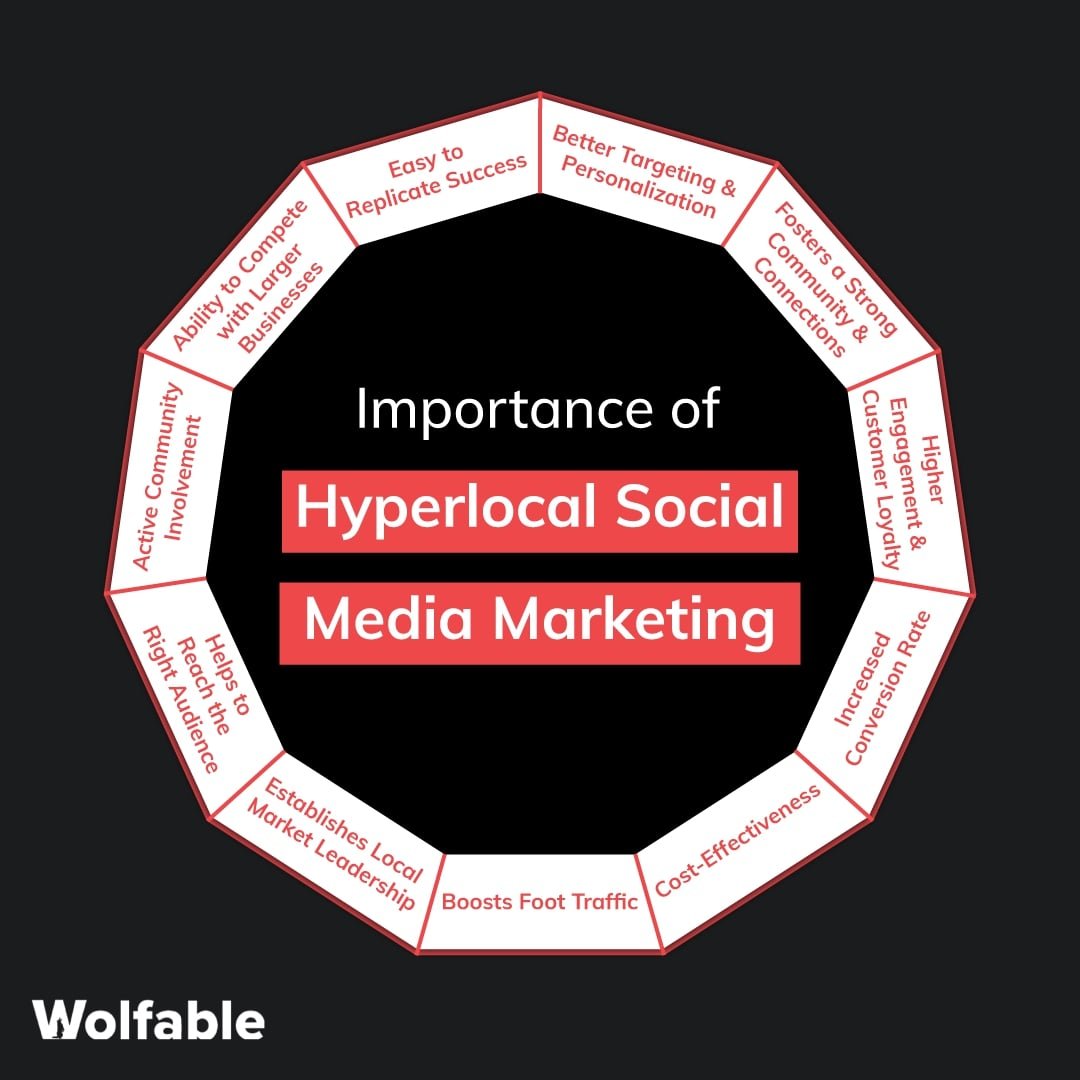
So, why should you care about hyperlocal social media marketing? Well, there are several compelling reasons:
-
- Better Targeting and Personalization:
With hyperlocal social media marketing, you can zero in on the specific geographic areas where your target customers live, work, or frequent. This allows for more personalized and relevant messaging, increasing the chances of capturing their attention and interest.
- Fosters a Strong Community & Connections:
Imagine your business as a local hub, a place people talk about and visit, not just for products but for the experience of connection. When you celebrate and showcase local landmarks, collaborate with nearby businesses, or spotlight community events, you do more than market products; you embed your brand into the local culture. This deepens trust and fosters a sense of community, setting the stage for meaningful collaborations that can lead to significant growth and expansion.
- Higher Engagement and Customer Loyalty:
Personalizing your interaction with customers in your area can transform how they see your business. It changes from a commercial entity into a local friend. For example, if you run a cafe and share stories of how your coffee beans are sourced from local roasters, you resonate with the community’s love for fresh and local products. Such actions show that you not only share their values but are actively contributing to what makes your community unique. This enhances customer loyalty and skyrockets engagement, as customers see your business as an integral part of their everyday lives.
- Increased Conversion Rate:
When your marketing messages are tailored to the local audience, they strike a chord. Your focus on the specific needs and interests of the community ensures that your promotions and posts are more relevant and appealing to the people who actually walk into your store or visit your website. This focused approach naturally leads to better conversion rates because your audience is already inclined to support local businesses.
- Cost-Effectiveness:
Compared to traditional advertising methods, hyperlocal social media marketing can be a more cost-effective way to reach your target audience. You're not wasting resources on irrelevant audiences; instead, you're focusing your efforts (and budget) on the people who matter most.
- Boosts Foot Traffic:
Hyperlocal marketing is particularly beneficial for physical stores. By engaging local social media users and highlighting proximity benefits, you can encourage people just around the corner to stop by, boosting foot traffic and increasing sales opportunities.
- Establishes Local Market Leadership:
Positioning yourself as a local authority in your industry through partnerships with local influencers and participation in community events can dramatically boost your credibility and authority. This makes your business the first place locals think of when they need your products or services.
- Helps to Reach the Right Audience :
By focusing your marketing efforts on the surrounding community, you target an audience that can easily access your business, making your marketing efforts more effective. This accessibility increases the likelihood of attracting and retaining a dedicated customer base.
- Active Community Involvement :
Participating in local events, supporting local causes, or sponsoring local teams are all ways to engage with your community actively. These actions help build strong community ties and loyalty, enhancing your brand’s visibility and embedding it into the local culture.
- Ability to Compete with Larger Businesses :
Even if you're a small or medium-sized business, hyperlocal social media marketing can level the playing field. By effectively targeting your local market, you can compete with larger brands that may have a broader reach but lack the localized focus and relevance.
- Easy to Replicate Success:
Successful hyperlocal marketing strategies can serve as a model for other areas. What works well in one community can often be adapted and replicated in another, allowing you to scale your success efficiently while minimizing risk.
- Better Targeting and Personalization:
Who Should Use Hyperlocal Social Media Marketing Strategy?
Hyperlocal social media marketing isn't just a buzzword—it's a powerful tool that can benefit a variety of businesses and organizations by focusing their marketing efforts on a specific geographic area.
Here’s a closer look at who can benefit from this approach and why it’s so effective for them.
Small Businesses and Startups with Limited Marketing Budgets
Small businesses and startups often operate with tight budgets, making every marketing dollar count. Hyperlocal marketing allows these businesses to concentrate their resources on a narrow, well-defined area. By doing so, they can maximize their reach and impact within their immediate vicinity without overspending.
For instance, a local bakery can use hyperlocal marketing to target residents within a 5-mile radius. By promoting daily specials and discounts through social media ads, the bakery ensures that its marketing efforts reach potential customers who are most likely to visit the shop.
This targeted approach is both effective and economical, allowing small businesses to compete with larger, more established companies.
Brick-and-mortar businesses (Retail Stores, Restaurants, Service Providers)
Brick-and-mortar businesses thrive on foot traffic. Retail stores, restaurants, and service providers can significantly benefit from hyperlocal marketing by drawing in customers from nearby areas. By targeting people who are physically close to their locations, these businesses can increase walk-ins and sales.
For example, a retail store can run a social media campaign highlighting new arrivals and special in-store promotions to attract shoppers in the neighborhood. Similarly, a restaurant can use location-based ads to promote daily specials, happy hour deals, or live music events to locals, driving more patrons through their doors.
Service providers like salons or repair shops can also benefit by advertising their services to nearby residents who need quick and convenient solutions.
Franchises and Multi-Location Businesses
Franchises and businesses with multiple locations face the challenge of maintaining consistent branding while catering to the unique characteristics of each location.
Hyperlocal marketing allows these businesses to tailor their campaigns for specific areas, ensuring that their marketing resonates with the local community.
For instance, a national coffee chain with multiple outlets can use hyperlocal marketing to promote different offers at each location. One outlet might run a campaign focused on morning commuters, while another might target university students with study-friendly promotions.
This customized approach helps each location build a strong local presence while maintaining the overall brand identity.
Event Organizers and Venue Owners
Event organizers and venue owners can leverage hyperlocal marketing to effectively promote their events and attract local attendees. By targeting people within the vicinity, they can increase event attendance and build a loyal following.
For example, a local theater can use social media to promote upcoming plays, concerts, or movie screenings to residents in the neighborhood. By highlighting unique aspects of the events and offering exclusive discounts to locals, they can draw in a larger audience.
Venue owners can also collaborate with local businesses and influencers to extend their reach and enhance the overall experience for attendees.
Real Estate Agents and Property Managers
Real estate agents and property managers need to connect with potential buyers and renters who are specifically interested in certain neighborhoods. Hyperlocal marketing helps them reach the right audience with targeted messages about properties in those areas.
A real estate agent can use hyperlocal social media ads to showcase new listings, open house events, and neighborhood highlights.
By focusing on specific zip codes or neighborhoods, they can attract clients who are actively looking for homes in those areas. Property managers can use similar strategies to fill vacancies quickly by targeting ads to people who are searching for rentals in particular locations.
Local Bloggers, Influencers, and Content Creators
Local bloggers, influencers, and content creators can use hyperlocal marketing to grow their audience and build a strong community presence.
Using hyperlocal social media marketing, they can engage with their followers more effectively and collaborate with local businesses for mutual benefit.
For example, a food blogger can create content around local restaurants, cafes, and food festivals, attracting readers who are interested in exploring the local culinary scene. By partnering with local eateries for reviews, giveaways, or special promotions, they can increase their reach and influence within the community.
Non-Profit Organizations and Community Groups
Non-profit organizations and community groups often rely on local support to achieve their goals.
Hyperlocal marketing helps them raise awareness, increase participation, and garner donations by targeting their immediate community.
A local charity, for instance, can use social media to promote fundraising events, volunteer opportunities, and community initiatives. By focusing on people within the community, they can build a dedicated base of supporters who are passionate about their cause.
Community groups can also use hyperlocal marketing to connect with residents, share important updates, and encourage community involvement.
Each of these entities faces unique challenges in reaching local audiences, but hyperlocal marketing provides them with the tools and strategies needed to overcome these obstacles.
When you focus on a specific geographic area and tailor messages to local interests and needs, you can build stronger connections and achieve better results.
How to Develop a Hyperlocal Social Media Marketing Strategy for Your Business?
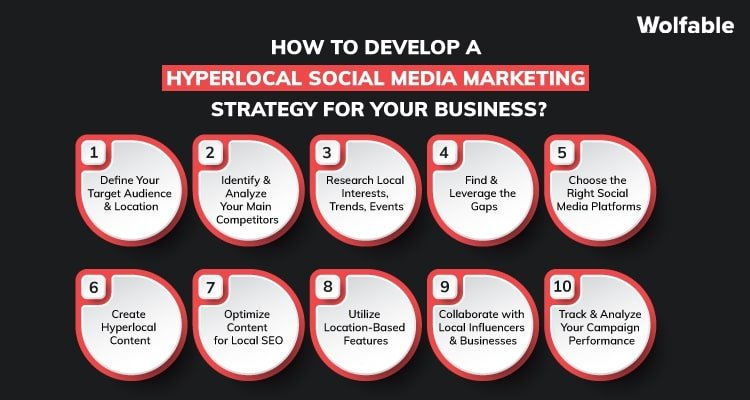
Creating an effective hyperlocal social media marketing strategy involves several key steps.
Each step helps you connect more deeply with your local audience and drive engagement and results.
Here’s how you can develop a strategy that works.
Step 1: Define Your Target Audience and Location
The first step in your hyperlocal social media marketing journey is to clearly define your target audience and location.
To do this, you need to start by identifying the specific geographic area you want to focus on. This could be a neighborhood, a district, or even a few streets around your business.
Once you have the location pinned down, think about the characteristics of your ideal customer in that area.
For this, you can consider factors such as age, gender, interests, and purchasing behavior. Understanding who you want to reach will help you tailor your messages more effectively.
Step 2: Identify & Analyze Your Main Competitors
Now, it's time to see who else is playing in your backyard. Identifying your main competitors gives you a clear understanding of who you're up against.
Start by listing businesses that offer similar products or services within your local area. Pay close attention to how they engage with their audience on social media.
What kind of content do they post? How often do they interact with their followers?
You can learn a lot by observing their tactics. For instance, note if they run local promotions or use certain hashtags that seem to get a lot of attention. Use this information to spot opportunities where you can do better or differentiate yourself.
Remember, the goal is not just to compete but to stand out by offering something unique or doing things in a way that resonates more with your local community.
Step 3: Research Local Interests, Trends, Events
The next step to create a hyperlocal social media marketing strategy is to immerse yourself in the local scene.
You can start by researching the interests, trends, and events that matter most to your community. This could include local festivals, popular hangout spots, or trending topics on local social media groups.
To obtain these data, you can use tools like Google Trends, local news websites, and social media platforms to gather insights. When you stay informed about what’s happening in your area, you can create content that resonates with your audience and feels relevant to their daily lives.
Step 4: Find & Leverage the Gaps
After getting to know your competitors, it's time to find the gaps.
These are opportunities where your competitors are not meeting the needs or expectations of the local audience. Maybe there's a lack of engaging content about local events or a missing personal touch in their interactions. Perhaps they are not using stories or live videos to show the human side of their business.
Your job is to identify these gaps and think about how you can fill them.
Can you offer more helpful, community-focused content? Could you be more responsive or personal in your social interactions?
This step is all about finding those little cracks where you can insert your business and shine. By addressing the unmet needs of your audience, you create a unique niche for your business in the local market.
Step 5: Choose the Right Social Media Platforms
Social media platforms are not all the same, especially for hyperlocal social media marketing.
Facebook, Instagram, and Nextdoor are particularly effective due to their strong location-based features.
Facebook offers detailed targeting options, allowing you to reach people based on their location, interests, and behavior.
Instagram is great for visual content and offers geotagging features that can highlight your business’s local presence.
Nextdoor is a community-focused platform where you can engage directly with neighbors and promote local events or deals. In short, you need to choose the platforms that best fit your audience and your business goals.
Step 6: Create Hyperlocal Content
Content is the heart of your hyperlocal marketing strategy.
In fact, if you want to succeed at hyperlocal social media marketing, you need to focus on creating content that speaks directly to your local audience.
This can include tips and guides related to your industry, local news updates, event announcements, and promotions.
For example, if you run a local bakery, share recipes, baking tips, or stories about where you source your ingredients locally. Additionally, you should also highlight your involvement in the community by showcasing partnerships with local businesses or sponsoring local events.
The more you can connect your content to the local area, the more engaging it will be.
Step 7: Optimize Content for Local SEO
To make sure your content gets seen by the right people, optimize it for local SEO.
The best way to do so is to use location-specific keywords in your posts and on your website. For example, you can consider adding phrases like “best coffee shop in [neighborhood]” or “top restaurants near [landmark]” to help search engines understand where your business is located and who it serves.
Apart from this, you must also ensure that your business information is consistent across all online platforms, including your website, social media profiles, and local business directories.
Step 8: Utilize Location-Based Features
Almost all social media platforms provide location-based features to enhance your hyperlocal strategy.
You can, for example, use check-ins to encourage customers to share their visits to your business, which can increase your visibility among their friends and followers.
In addition to this, geotagging your posts and stories on Instagram can attract users searching for content in your area.
If you want to go one step beyond this, you can always run local ads on Facebook that can help target specific geographic areas with tailored messages. These features help you reach people who are nearby and likely to visit your business.
Step 9: Collaborate with Local Influencers and Businesses
If you want to further expand your reach, consider partnering with local influencers and businesses.
For best results, look for influencers who have a strong following in your area and whose audience aligns with your target customers. Then, collaborate on joint promotions, events, or content to tap into their established audience.
For instance, if you own a fitness studio, you could partner with a local health food store to offer a combined promotion.
Such collaborations not only increase your visibility but also build credibility within the community.
Step 10: Track and Analyze Your Campaign Performance
Finally, it’s time to track and analyze your hyperlocal campaign performance to understand what’s working and what’s not.
For this, you can use analytics tools provided by social media platforms to monitor key metrics like engagement rates, foot traffic, and sales.
In these tools, we recommend checking which types of posts generate the most interaction and which ads drive the most traffic.
When you regularly review these metrics, you can make better, data-driven decisions and adjust your strategy for better results. If a particular type of content is performing well, create more of it. If an ad isn’t delivering as expected, tweak the targeting or message.
Examples of Hyperlocal Social Media Marketing
Let's check out some examples of hyperlocal social media marketing that's been done right.
Hardee's
Hardee's uses a very effective hyperlocal marketing strategy to drive in customers through specific local deals.
Through the use of their social media channels, they have precisely targeted specific locations, showcasing time-barred offerings to be availed in stores starting from 2 pm. This creates a sense of urgency and locality, pushing the customer to head to their nearest Hardee's and grab the opportunity that the deal is bringing to him.
This kind of example proves how social media channels, in this case—Facebook, have targeted advertising, which enables businesses to reach their audience with pinpoint precision in terms of users' age, location, interests, and hobbies, among others.
Such hyperlocal targeting ensures that the marketing message will be delivered to the most fitting type of audience, and engagement and conversion rates can rise because of that.
Bobo's Coffee and Brunch
Bobo's is a great example of hyperlocal social media marketing. This Putnam County, New York-based local shop fills you in on ideas of what you need to do to ace it in the coffee and brunch space.
A combination of showcasing mouth-watering food and a sprinkle of humor makes their content relatable while using the functionalities of the respective social media platform smartly.
-
- Reels: They majorly use Reels to engage the audience. Reels' dynamism and interactivity in format gives them an opportunity to show food in such an inviting way.
- Geo-Targeted Giving: They use the local hashtag so that their content can easily be searchable by the local community.
- Large Appeal: It has four busy stores but feels local. The appeal to the audience is massive, as it fits the niche of all the people interested in differing age groups. It says it is just right that they understand the preferences of different age groups in their local community.
- Engagement Type: The content is triggering humor everywhere, hence their social media channels are informative and at the same time, entertaining, too.
Tim Hortons Cafe and Bake Shop in Texas and Georgia
For a long time, Tim Hortons has been a household name in Canada, and for them to create a 'local' presence in places such as Texas and Georgia, where it's actually a 'foreign' local brand, takes a lot of work.
And the strategy follows a twist in the story:
-
- De-branding regionalism: Tim Hortons had to build a brand story that went beyond its origin and, instead, grew feet into the local subconscious in the Southern states.
- Tailoring to local tastes: For them, it meant appealing to the specific taste and preference sets of the Southern audience. They did that by providing a highly localized menu and marketing that emphasized this localization, showing that 'these are items locals enjoy here for generations'.
- Engaging with southern charm: Tim Hortons created a sense of local familiarity but made people curious to experience and anticipate their service. It was a well-crafted story that portrayed the brand as a neighborly presence, like a coffee shop that's 'just around the corner'.
- Synchronizing with community events: Local events and trends directly aligned with the understanding and appreciation of local culture. Strategic brand integration created the feeling that Tim Hortons is part of the local community fabric within Texas and Georgia.
With all of those moves, Tim Hortons did an excellent job of entering a Southern U.S. market with a Canadian brand but making it feel local—as local as biscuits and gravy, but on a healthier mission.
Conclusion
So, in a nutshell, hyperlocal social media marketing is a powerful strategy that helps businesses make a large local impact.
By localizing their content's structure and direction to what is wanted and needed in the local environment, they can build great connections, drive engagement, and eventually increase conversions.
It is productive in nature, aligns with the right audiences, and allows a sense of community and loyalty to the customers.
If you are looking forward to using the power of hyperlocal social media marketing in business, contact Wolfable.
We are adept at crafting engaging, effective marketing strategies that are targeted and, more importantly, speak to your local audience. You can contact us today to learn more about how we can help grow your business and achieve your set marketing goals.


